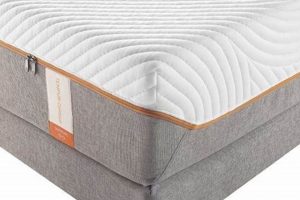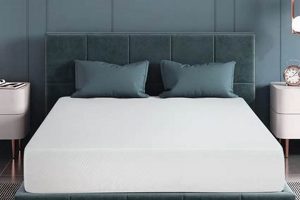This type of bedding integrates viscoelastic foam with cooling gel particles. Viscoelastic foam conforms to the body’s shape, distributing weight and alleviating pressure points. The inclusion of gel aims to dissipate heat, mitigating the temperature retention commonly associated with standard viscoelastic foam. This design seeks to provide both support and a cooler sleeping surface.
The development of temperature-regulating bedding reflects a growing consumer demand for improved sleep quality. Enhanced comfort, facilitated by pressure relief and thermal regulation, can contribute to a more restful sleep experience. Historically, traditional mattresses lacked effective temperature control, leading to discomfort for some individuals. Modern iterations address this concern through innovative material science and engineering.
The following sections will explore the specific properties of viscoelastic foam, the mechanisms of cooling gel technology, and the overall impact on sleep quality and user satisfaction. These elements contribute to a comprehensive understanding of this increasingly prevalent bedding option.
Optimizing Performance and Longevity
The following guidelines aim to maximize the lifespan and effectiveness of this bedding technology, ensuring consistent comfort and support over time.
Tip 1: Employ a Suitable Foundation: A solid, supportive bed frame or platform is essential. Slatted frames should have slats spaced closely enough to prevent sagging or uneven wear. The foundation directly impacts the long-term structural integrity.
Tip 2: Utilize a Mattress Protector: A waterproof, breathable protector shields against spills, stains, and dust mites. This preventative measure prolongs the lifespan by maintaining cleanliness and preventing degradation of the foam and gel layers.
Tip 3: Rotate Regularly: Rotate the mattress 180 degrees every six months. This practice evens out wear patterns and prevents localized compression, particularly in areas where body weight is concentrated.
Tip 4: Ensure Adequate Ventilation: Allow airflow around the mattress by avoiding enclosure in overly restrictive bedding. Proper ventilation helps dissipate moisture and maintain the cooling properties of the gel-infused layer.
Tip 5: Vacuum Periodically: Use a vacuum cleaner with an upholstery attachment to remove surface debris and dust. Regular vacuuming maintains hygiene and prevents the accumulation of allergens within the mattress fibers.
Tip 6: Address Spills Immediately: In the event of a spill, blot the affected area with a clean, absorbent cloth. Avoid using harsh chemicals or excessive moisture, which can damage the foam and compromise its structure. Professional cleaning may be necessary for extensive stains.
Consistent adherence to these recommendations will contribute to sustained performance and enhanced durability. The resulting benefits include prolonged comfort, optimal support, and a healthier sleep environment.
The subsequent section will offer guidance on selecting a suitable option, considering factors such as density, thickness, and gel concentration, to ensure a purchase that aligns with individual needs and preferences.
1. Temperature Regulation
The integration of cooling gel within viscoelastic foam directly addresses the issue of heat retention. Traditional viscoelastic foam, while effective in pressure relief, tends to trap body heat, leading to discomfort for some sleepers. The gel component functions as a thermal conductor, drawing heat away from the body and dissipating it across the mattress surface. This mitigates overheating and promotes a more consistent sleep temperature. A practical example is observed in regions with warmer climates, where individuals report improved sleep quality due to the enhanced thermal regulation provided by these mattresses.
The efficacy of temperature regulation varies depending on the concentration and distribution of the cooling gel. Mattresses with a higher density of gel particles or a layered gel structure typically exhibit superior cooling performance. Furthermore, the type of gel used can influence its thermal properties. Phase-change materials, for example, absorb and release heat to maintain a stable temperature. This contrasts with simpler gel infusions that primarily rely on conductive heat transfer. The design and construction directly affect the mattress’s ability to regulate temperature effectively throughout the night.
Effective temperature regulation represents a crucial component of sleep comfort and, consequently, overall sleep quality. By mitigating heat buildup, these mattresses can reduce tossing and turning, leading to a more restful and uninterrupted sleep cycle. The challenges lie in maintaining the cooling effect over extended periods and in adapting the design to suit individual temperature preferences. However, understanding the principles of thermal conductivity and material science allows for the continued refinement and optimization of temperature-regulating bedding technologies.
2. Pressure Relief
Viscoelastic foam’s defining characteristic is its ability to conform to the body, thereby distributing weight more evenly than traditional innerspring mattresses. This property is especially relevant in the context of pressure relief, as it reduces concentrated stress on specific areas of the body.
- Weight Distribution
Viscoelastic foam responds to both weight and temperature, molding to the individual’s contours. This eliminates localized pressure points, particularly at the shoulders, hips, and knees, which are common areas of discomfort during sleep. This reduction in pressure facilitates improved circulation and minimizes tossing and turning.
- Spinal Alignment
By conforming to the body’s natural curves, this bedding promotes proper spinal alignment. This is crucial for alleviating back pain and preventing the development of musculoskeletal issues. A correctly aligned spine reduces strain on the muscles and ligaments, leading to a more restful sleep experience.
- Impact Absorption
The foam effectively absorbs and dampens movement, minimizing motion transfer across the mattress surface. This is beneficial for couples, as it reduces disturbances caused by one partner’s movements. The ability to isolate motion contributes to a more peaceful and uninterrupted sleep for both individuals.
- Adaptability to Sleeping Position
Whether an individual prefers to sleep on their side, back, or stomach, viscoelastic foam adapts to their body’s shape and provides consistent support. This versatility ensures that pressure relief is maintained regardless of sleeping position, promoting comfort and preventing the development of aches and pains associated with imp
roper support.
The combined effect of these facets underscores the significance of pressure relief in the overall design and functionality of viscoelastic bedding. By mitigating concentrated stress and promoting proper spinal alignment, these mattresses contribute to improved sleep quality and reduced discomfort, ultimately enhancing the overall sleep experience.
3. Density Variation
Density variation in viscoelastic foam directly influences the performance and longevity of a cool gel mattress. Density, measured in pounds per cubic foot (PCF), dictates the foam’s support characteristics, durability, and heat retention properties. Higher density foam provides greater support, resists compression over time, and tends to retain more heat. Conversely, lower density foam offers less support, is more susceptible to compression, and allows for better airflow.
The integration of cooling gel partially mitigates the heat retention associated with higher density foam. However, the core density remains a critical factor in determining the mattress’s overall feel and long-term performance. For example, a high-density (5 PCF) foam layer infused with cooling gel offers substantial support and durability, suitable for individuals seeking a firm feel and long-lasting mattress. A low-density (3 PCF) foam layer, even with gel, will provide a softer feel but may degrade more quickly and offer less support, potentially leading to pressure point development over time. The choice depends heavily on individual preferences and needs, especially considering body weight and sleeping position.
Ultimately, density variation represents a crucial factor in the selection of a viscoelastic cool gel mattress. Understanding the trade-offs between support, durability, and temperature regulation allows consumers to make informed decisions based on their specific needs. While cooling gel technology addresses thermal concerns, the inherent density of the foam dictates the mattress’s foundational characteristics and long-term suitability.
4. Support Structure
The support structure within a viscoelastic cool gel mattress dictates its overall functionality and longevity. This structure typically comprises a combination of materials, including the viscoelastic foam itself, a supportive base foam layer, and, in some cases, an innerspring system. The quality and arrangement of these components directly impact the mattress’s ability to provide adequate spinal alignment, distribute weight effectively, and resist sagging over time. A poorly designed support structure can negate the benefits of the viscoelastic foam and cooling gel, leading to discomfort and premature wear.
Consider a mattress with a high-density viscoelastic foam comfort layer but a low-density base foam. The comfort layer may initially provide adequate pressure relief, but the inadequate base will compress quickly, resulting in sagging and a loss of support. This can lead to back pain and an uneven sleeping surface. Conversely, a mattress with a robust base foam and a thinner viscoelastic layer may offer sufficient support but lack the pressure-relieving benefits of the conforming foam. A balanced design, where the support structure complements the properties of the viscoelastic and gel layers, is essential for optimal performance. Hybrid models incorporating innerspring systems offer a blend of targeted support and motion isolation.
In conclusion, the support structure is not merely an ancillary component but an integral element of a viscoelastic cool gel mattress. Its design directly influences the mattress’s ability to provide long-term support, maintain spinal alignment, and resist sagging. Selecting a mattress with a well-engineered support structure is crucial for ensuring a comfortable and restorative sleep experience and maximizing the lifespan of the product.
5. Conformability
Conformability, in the context of bedding, refers to the degree to which a mattress adapts to the contours of the body. Viscoelastic foam, the primary material in a memory foam cool gel mattress, possesses a unique ability to deform under pressure and slowly return to its original shape when the pressure is removed. This characteristic directly impacts the distribution of body weight across the sleeping surface. Enhanced conformability equates to a more even weight distribution, reducing pressure points and promoting spinal alignment. Without this property, concentrated pressure would lead to discomfort and potential sleep disruption. For example, an individual with scoliosis may experience significant relief due to the mattress’s ability to accommodate the curvature of the spine, minimizing pressure on sensitive areas. The inclusion of cooling gel does not inherently alter the conformability of the foam, but it addresses the thermal implications often associated with the material’s close contact with the body.
The level of conformability varies depending on the density and composition of the viscoelastic foam. Higher density foam generally provides more support but may exhibit less pronounced conforming properties compared to lower density alternatives. The ideal level of conformability depends on individual preferences, body weight, and sleeping position. Side sleepers, for instance, often benefit from greater conformability to alleviate pressure on the hips and shoulders. Back sleepers require a balance of conformability and support to maintain proper spinal alignment. Stomach sleepers typically benefit from firmer surfaces that prevent excessive sinking and potential back strain. The practical application of this understanding involves selecting a mattress with a conformability level that aligns with the individual’s unique needs and physical characteristics.
In summary, conformability is a critical attribute of a memory foam cool gel mattress, influencing pressure relief, spinal alignment, and overall sleep comfort. The selection of a mattress with an appropriate level of conformability requires careful consideration of individual factors such as body weight, sleeping position, and specific physical conditions. While cooling gel addresses thermal concerns, the underlying conformability of the viscoelastic foam remains paramount in determining the mattress’s overall effectiveness. The challenge lies in balancing conformability with adequate support to achieve optimal sleep quality.
Frequently Asked Questions
The following questions address common inquiries and concerns regarding memory foam cool gel mattresses. The intent is to provide factual information to facilitate informed decision-making.
Question 1: What is the expected lifespan of a memory foam cool gel mattress?
The lifespan is contingent upon several factors, including foam density, usage patterns, and maintenance practices. Generally, a high-quality memory foam cool gel mattress can last between 7 to 10 years with proper care.
Question 2: Does a memory foam cool gel mattress sleep cooler than traditional memory foam?
Yes, the inclusion of cooling gel is intended to dissipate heat, mitigating the heat retention often associated with standard memory foam. The degree of cooling varies depending on the gel concentration a
nd technology employed.
Question 3: Are memory foam cool gel mattresses suitable for individuals with back pain?
The conforming properties of memory foam can provide pressure relief and promote spinal alignment, potentially alleviating back pain. However, individual results may vary, and consulting with a medical professional is advisable.
Question 4: What is the ideal foundation for a memory foam cool gel mattress?
A solid, supportive foundation is recommended to prevent sagging and ensure proper weight distribution. Slatted frames are acceptable, provided the slats are closely spaced.
Question 5: How should a memory foam cool gel mattress be cleaned?
Spot cleaning with a mild detergent and water is recommended for spills. Avoid harsh chemicals or excessive moisture. Professional cleaning services may be necessary for extensive stains.
Question 6: Do memory foam cool gel mattresses have an initial odor?
A slight odor, often referred to as “off-gassing,” may be present upon initial unboxing. This odor is typically harmless and dissipates within a few days in a well-ventilated area.
In summary, the performance and longevity of this bedding depends on the interplay of material quality, construction techniques, and user maintenance. Understanding these elements empowers informed choices.
The following section will explore a comparative analysis of different mattress types.
Memory Foam Cool Gel Mattress
This exploration has outlined the core attributes of the memory foam cool gel mattress, encompassing its composition, functionality, and maintenance requirements. Key aspects, including pressure relief, temperature regulation, density variations, support structure, and conformability, have been addressed. The analysis underscores the interplay between these elements in determining the overall performance and suitability of this bedding type.
The ongoing development of sleep technology signifies a continued pursuit of enhanced sleep quality. Further research into material science and ergonomic design will likely refine and optimize the performance of the memory foam cool gel mattress. Consumers are encouraged to critically assess their individual needs and preferences when selecting a mattress to ensure a purchase that promotes restorative sleep and long-term well-being.


![Best Memory Foam Camper Mattress [Deals!] Organic & Natural Mattress Buyer’s Guide: Non-Toxic Sleep Solutions Best Memory Foam Camper Mattress [Deals!] | Organic & Natural Mattress Buyer’s Guide: Non-Toxic Sleep Solutions](https://mattressworldpa.com/wp-content/uploads/2025/07/th-4035-300x200.jpg)

![Best Memory Foam Futon Mattress for Comfy Sleep [Guide] Organic & Natural Mattress Buyer’s Guide: Non-Toxic Sleep Solutions Best Memory Foam Futon Mattress for Comfy Sleep [Guide] | Organic & Natural Mattress Buyer’s Guide: Non-Toxic Sleep Solutions](https://mattressworldpa.com/wp-content/uploads/2025/07/th-4033-300x200.jpg)


